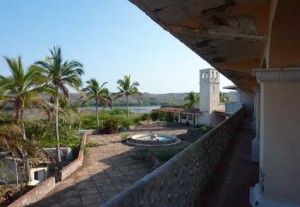Location: In the northern part of the state of Guerrero, camped next to a mangrove. Two river mouths form a broad delta in this area. In a palapa near the beach, women prepare tamales over a wood-burning oven.
Conditions: The lovely mangroves unfortunately spawn lots of mosquitoes, which force a decision: whether to use chemical repellent DEET, hide under long-sleeve clothes in the sweaty heat or be bitten and risk the possible dengue fever advertised in warning posters around local towns? Perhaps I should seek higher ground.
Discussion: Perceptive readers have probably wondered about the strange mix of topics we’ve covered — ranging from floods and fisheries to tourism development and drug production. What is the relationship between these issues and their significance to this voyage’s theme of “exploring the effects of climate on Mexico’s coastline?” This might be a good opportunity for a bird’s-eye view, using island examples and past societies for perspective.
The original inspiration for this trip came from low-lying atolls, such as Kiribati. In those atolls, climatic pressures including sea-level rise and reduced rainfall are turning decades of poor resource management (e.g. freshwater extraction and waste disposal) into a full-blown crisis. Many small island states such as Kiribati, Vanuatu and the Maldives are talking about evacuations of their populations as “climate refugees” in the next 50 years. Are they simply victims of the First World’s thirst for fossil fuels, or do they bear responsibility for putting themselves in a precarious condition?
Most likely, both factors are true. Due to their low-altitude coral structure and limited resources, they are vulnerable to begin with. Excessive pollution and short-sighted development, meant to boost standards of living, leave a narrow margin for error. For example, there is less surplus of freshwater to buffer periods of drought. As climatic pressures shrink those narrow margins — via saltwater intrusion, rainfall scarcity or storms — crises can quickly evolve.

Effects are not uniform across the board. Contradicting the widespread fear that all islands are sinking (i.e. being swallowed by sea-level rise), a recent report suggested that some islands might actually be growing due to increased wave action, as coral is deposited on land after storms. Politicians eager to bail out their countries might exaggerate global warming claims to get support for needed changes. Nevertheless, the reality remains that these places are vulnerable, weakened by pollution and climatically tipping over the edge.
In his book Collapse: How Societies Choose to Fail or Succeed, University of California, Los Angeles, polymath Jared Diamond uses examples of both ancient and modern civilizations to illustrate how a society can spiral downward.
At Easter Island, the site of mysterious stone statues erected between the 12th and 16th centuries, archeology and pollen analysis have shown that the 15,000-plus inhabitants completely deforested their island, which is now a barren landscape of shrubs and small trees. Major forests on the island included the extinct giant palm tree, the world’s largest, which was used for canoe building and transport of the stone monuments. Deforestation led to reduced crop yields due to erosion and lack of protection from sun and wind, as well as a lack of timber for construction and canoes. Once wild food sources plummeted, civil wars ripped the island’s social fabric, which, along with starvation, led to a population crash (although other interpretations of the collapse do exist).
Another less-known decline of a Polynesian society was in the Pitcairn Islands, made famous by the mutineers of the H.M.S. Bounty who resided on the otherwise uninhabited island for years. The case showed an example where collapse was “triggered by the breakdown of an environmentally damaged trade partner” — the island of Mangareva. It fell for similar reasons as Easter Island (a fragile environment that was deforested and eroded to the point of civil wars and starvation) and failed to support the two smaller outpost islands of Henderson and Pitcairn whose populations slowly died.
In the 11th century, in what is now southwest Colorado, the Anasazi people built the continent’s tallest buildings until Chicago’s steel skyscrapers surpassed them in the 1880s. The Anasazi’s collapse is attributed to droughts and other climatic changes that tipped the already abused, fragile and overpopulated landscape over the edge.
In the 10th century, the Mayan civilization, which supposedly declined for similar reasons, despite having millions of people, the social infrastructure to build massive stone temples and the New World’s only known writing system. These cases revealed common trends leading to decline: the over-exploitation of resources, overpopulation, a society’s inability to adapt and climatic tipping points that put the proverbial nail in the coffin.

Meanwhile, success stories from societies that adapted to and overcame their mounting environmental problems showed that peoples’ choices do matter, for example, as they did in Iceland, the New Guinea highlands, the miniscule island of Tikopia and 18th-century Japan.
The role that climate pressures have on coral atolls like Kiribati, and had on past societies around the world, are useful cases because of their relative simplicity. Although Mexico is a much more complex and robust country than small island nations (and continental Anasazi and Maya), the same set of principles is evident: somewhat vulnerable environments weakened by human modification, operating on an increasingly narrow margin of resources, which could be further undermined by climatic pressures.
Whereas the potential of collapse is low, the likelihood of serious downturns is higher, which could affect its neighbors through trade, mass immigration and other spillovers. Not that environmental degradation directly causes declines, though it might be one of the original causes. The proximate factors are more often war and immigration. In Mexico, poverty associated with environmental degradation has amplified, if anything, social problems like the drug war and illegal immigration.
Therefore, the different topics covered along this voyage have been about how the environment in Mexico is becoming stronger or weaker, which in turn makes it more or less resilient to economic and atmospheric changes. Resilience is the key concept that ensured the well-being of past societies faced with radical changes. It will also be important for our modern world, faced with “climate weirding,” exploding affluent (and poor) populations, biodiversity crashes and petro-dictatorships, as Thomas Friedman puts it in his book Hot, Flat, and Crowded. Because of these factors, Friedman argues that greening the economy is now a matter of national security and economic survival.
Many energy and water policies based on old growth models are reducing our resilience. Are there development models that can strengthen ecosystems and communities? Coming fresh off a half-century expressly devoted to GDP growth, we are now having to re-learn how to do things better, not just bigger, as I discovered in my next stop in southern Mexico.




